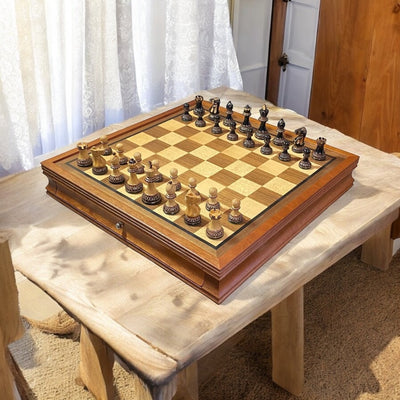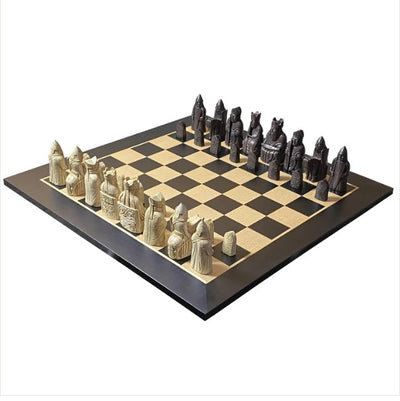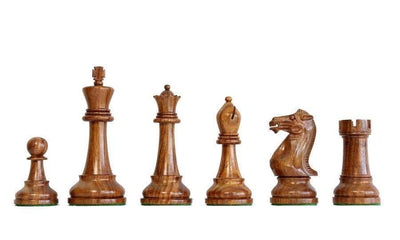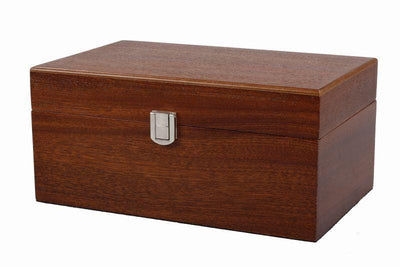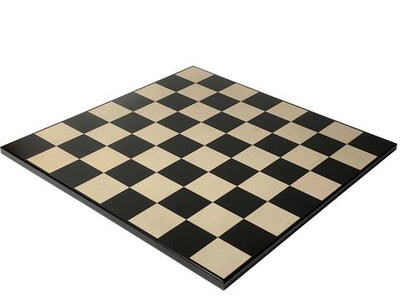Ancient predecessors and games associated with them
It is still a controversial question on where chess originated. There's no evidence to suggest that chess existed before the 6th Century CE. The sport pieces discovered in Russia, China and Central Asia, Pakistan and other countries that are dated to ahead of that date are now considered to be from distantly related board games. These boards often used 100 squares or more and regularly involved dice.
Chaturanga may be a simulation that was played in ancient India. It is a Sanskrit term for a battle formation, which was mentioned within the Indian epic Mahabharata. Chaturanga, which was found in northern India within the 7th century, was considered the primary precursor to modern chess. It had two key characteristics that were common altogether with later chess variations: different pieces had different powers (unlike go and checkers), and victory was firm by one piece, the king in modern chess.
It is not clear how chaturanga developed. Chaturanga was a game played on 64 square boards with dice. It's believed that chaturanga evolved into Shatranj or Chatrang, a two-player game within the northern parts of Central Asia, Pakistan, Afghanistan and other countries after 600 CE. Shatranj was a variation on chaturanga, but it added a brand new piece: a firzan (counselor), that had nothing to try and do any troop formations. A shatranj game can be won by either eliminating all the pieces of an opponent (barring the king) and/or by capturing the king. While the initial positions of the knights and pawns are the identical, there have been significant regional and temporal variations within the placements of the opposite pieces.
It took on radically different characteristics because it spread to the west, east, and north. Within the East, carried by Buddhist pilgrims, trade route traders, and others, it had been transformed into a game with inscribed disks that were often placed on the intersection of the lines of the board instead of within the squares. About 750 CE chess reached China, and by the 11th century it had come to Japan and Korea. Chinese chess, the foremost popular version of the Eastern game, has 9 files and 10 ranks in addition as a boundary--the river, between the 5th and 6th ranks--that limits access to the enemy camp and makes the sport slower than its Western cousin.
Introduction to Europe
Chaturanga or shatranj, a sort of chaturanga, made its thanks to Europe via Persia and therefore the Eastern Roman Empire. But perhaps most significantly, it had been a product of the expanding Arabian Empire. During a 10th century manuscript was found the oldest known game. It had been played by a Baghdad historian who is believed to have been a favourite of three successive caliphs and a student.
Muslims brought chess to geographical areas, Sicily, and Spain by the 10th century. Eastern Slavs spread it to Kievan Rus about the same time. The Vikings brought the sport to England and Iceland. they're also believed to have created the foremost famous collection of Chessmen: 78 pieces of walrus-ivory from various sets, which were discovered on the Isle of Lewis in Outer Hebrides in 1831. These pieces start in the 11th or 12-century. See Figur 2.
King and non secular leaders would occasionally ban dice and chess games. For instance, King Louis IX forbade the sport in France in 1254. The game's social appeal helped it to become very fashionable. A set was often associated with wealth, knowledge, power. it absolutely was a favourite of King King of Great Britain, Henry II and John of England, in addition as Philip II and Alfonso X of Spain and tzar (the Terrible). it absolutely was already referred to as the royal games within the 15th century.
Standardization of rules
Modern rules and also the appearance of pieces have evolved slowly with plenty of regional variation. For instance, by 1300, the pawn could move two squares in its first turn rather than one because it was under shatranj. This rule wasn't accepted in Europe for over 300 years.
Two crucial rule changes after 1475 made Chess more popular. Until then the counselor was limited to moving one square diagonally at a time. And, because a pawn that reached the eighth rank could become only a counselor, pawn promotion was a comparatively minor thing about the course of a game. But under the new rules the counselor underwent a modification and gained vastly increased mobility to become the foremost powerful piece on the board--the modern queen. This and also the increased value of pawn promotion added a dynamic new element to chess. The elephant chaturanga piece, also referred to as the chaturanga, was made by the bishop. Its range has been over doubled since then.
Before these changes, checkmate was rare and games were decided by bareing the king. The new queen and bishop power replaced medieval chess' trench warfare with a game where checkmate may be achieved in only two moves.
Acceptance of the last two major changes to the principles, casting and therefore the in passing capture, took longer. These rules were well-known within the 15th century, but only a little number of individuals used them until the 18th. Minor changes to other rules were continued up to the late 19th Century. As an example, it has been unacceptable in many European countries to push a queen to a pawn if the initial queen continues to live.
Set design
Since chaturanga time, the looks of the pieces have varied between simple and elaborate. Before 600 CE, pieces were simple and portrayed animals, warriors, or noblemen. The 9th-12th century Muslim sets were often non-representative and made up of simple clay or carved stones, following the Islamic ban on images of living creatures. It's believed that the recognition of the sport was boosted by the return to simpler, symbolic shatranj pieces. This made it easier to make sets and diverted players' attention far from the complicated pieces to the sport.
Stylized sets, often adorned with precious and semi-precious stones, returned to fashion because the game spread to Europe and Russia. By 1000 CE, playing boards that were monochromatic within the Muslim world began to get replaced by alternating black-and-white squares or red-and white squares. They were made from fine wood and marble. Peter the Great (the great) of Russia carried special campaign boards made of soft leather during military operations.
The king became the biggest piece and bought a crown and sometimes an elaborate throne and mace. Chaturanga shows that the knight is closely related to the horse. because the lowest in social standing and power, the pawn has always been the tiniest and most representative of the pieces. The queen grew in size after 1475, when its powers expanded, and altered from a male counselor to the king's female consort. The bishop was known by different names--"fool" in French and "elephant" in Russian, for example--and wasn't universally recognized by a particular mitre until the 19th century. Depiction of the rook also varied considerably. It had been most typically depicted in Russia as a sailing vessel until the 20th Century. Elsewhere it absolutely was a warrior during a chariot or a castle turret.
With an easy design by Nathaniel Cook, an Englishman who was born in 1835, the quality for contemporary sets was established. The planning was patentable in 1849 by Howard Staunton, who was then the simplest player within the world. Staunton promoted it extensively, and it became the Staunton pattern. International competition is restricted to sets that support the Staunton pattern. consult with Figure 3.
FIDE and therefore the world championship
For the past two centuries, chess' popularity has been tied closely to the competition for the title of world champion. This can be usually exhausted two-player matches. Although the title wasn't officially established until 1886, widespread interest within the game has been present for quite 50 years. Six matches between British and French players Louis-Charles de la Bourdonnais (of Paris) were held in 1834. They ended with Bourdonnais winning. A serious chess tournament was first reported within the newspapers and analysed in books. Following Bourdonnais's death in 1840, he was succeeded by Staunton after another match that gained international attention, Staunton's defeat of Pierre-Charles Fournier de Saint-Amant of France in 1843. The match was also a catalyst for stakes competition. Staunton won the PS100 that supporters put up.
Staunton used his status as unofficial world champion so as to popularize the Staunton pattern set, promote uniform rules and organize the primary international tournament in London, 1851. Karl Ernst Adolf Anderssen, a German school teacher, was inspired by the Bourdonnais-McDonnell match to show from problem composing to tournament competition, and he won the London tournament and with it recognition as unofficial champion. American players were inspired by the London tournament to prepare the primary American Chess Congress in ny City in 1857. This event set out the Western Hemisphere's first chess craze. After defeating Anderssen 1858, Paul Morphy, from point of entry was declared the unofficial champion of the planet.
After Morphy's retirement, the planet championship was made more formal when Anderssen was defeated in Prague by Wilhelm Steinitz in an 1866 match. Steinitz was the primary person to possess the facility to determine how a title match should occur. He established a group of economics and rules that might allow him to defend his position as the world's best player. In 1886, he agreed with Johann Zukertort from Austria to require part within the first match designated for the globe championship. Steinitz had the choice to decide on who he would accept as a challenge and the way often he would defend it.
Emanuel Lasker, a German successor to Steinitz, was a far tougher champion in organizing matches than Steinitz. His title wasn't defended for long periods of time, between 1897 and 1907, then from 1910 to 1921. After the leading national chess federations, Brits and German, did not arrange a match between Lasker and any of his leading challengers on the eve of warfare I, the momentum for an independent international authority began to grow.
The controversy surrounding the championship was eased by Jose Raul Capablanca, Cuba, defeating Lasker in 1921. He also won an agreement at a tournament held in London in 1922 between the highest players of the globe to make a collection of rules for championship challenges. The foundations stipulated that any player who could meet certain financial requirements (including a guarantee of a $10,000 stake) could challenge Lasker to become the planet Champion. While the simplest players tried to follow the London Rules, 15 countries met in Paris to make the primary permanent international chess organization, FIDE. This acronym stands for Federation Internationale des Echecs.
The London Rules worked smoothly in 1927 when Capablanca was dethroned by Alexander Alekhine, the primary Russian-born champion, on the other hand proved to be a financial obstacle in
Capablanca's bid for a rematch. FIDE didn't intervene. Alekhine was widely criticised for manipulating rules. FIDE took over the organization of world championship matches after he died in 1946.
FIDE's match tournaments were organized by FIDE in 1948 to fill Alekhine's vacancy. The FIDE format continued to be used until 1975. To work out the planet Champion challengers, the international federation held three-year cycles that included international and regional competitions. It also solicited bids for match locations. The title was now not held by the champion, but he or she had to defend it every three years.
FIDE also took over the Women's World Championship and biennial Olympiad team championships, which originated within the 1920s. The federation also created new championship titles, especially for junior players of various age groups. It created a system to acknowledge top players by arithmetic rating or by titles based upon tournament performance. The best title, after World Champion, is grandmaster, of whom there are now over 500 within the world.
The easing and eventual end of the conflict spurred international chess by reducing barriers. Nearly 2,000 tournaments were being held each year by FIDE within the mid-1990s, quite 50 times as many because of the 1950s. Amateur chess expanded sharply. The U.S. membership grew rapidly. the number of members within the U.S. Chess Federation increased from 2,100 in 1957, to over 70,000 by 1973.
All World Champions and challengers from 1951 to 1969 were Soviet citizens, and every one the championship matches were held in Moscow with small prizes and limited international publicity. Robert J. Fischer's victory was a sudden change. The sudden change within the 1972 victory of Robert J. Fischer (Bobby) Fischer, u. s. was a shock. Fischer's demands led to a $250,000 increase within the prize, which is quite any previous title match combined. Fischer demanded a greater role in match rules after winning the highly publicized match. Fischer objected to the FIDE rule that restricted championship matches to 24 games, which was in effect since 1951. FIDE dropped the rule, but Fischer demanded further concessions. In the end he refused to defend his title; in 1975 he became the primary champion by default.
Fischer's successor, Anatoly Karapov of state, ruled for ten years, but was overthrown by Garry Kasparov, a bitter countryman. Kasparov clashed with FIDE repeatedly over rules for the championship. He agreed to defend his title thrice under the foundations of the federation, whenever winning. When Nigel Short, an English chess champion, won the challenge to challenge Kasparov within the 1993 championship, Kasparov and Short decided to instead play the match under the auspices of a replacement organization called the Professional Chess Association. FIDE disqualified Kasparov in London in late 1993 and arranged its own match for the globe championship. it had been won by Karpov.
FIDE started holding annual "knockout” tournaments in 1999 to come to a decision on its champion. the primary tournament was won by Alexander Khalifman from Russia. It befell in Las Vegas, Nevada. The tournament was held in metropolis, Nevada, between the Indian capital, India and Tehran, Iran. In 2000, Viswanathan Anand of India won the title match. Meanwhile, Kasparov lost a title match to Vladimir Kramnik of Russia in 2000.
Following negotiations with FIDE, which recognized Kramnik as the "classical" world chess champion, he agreed to a unification match in 2006 with FIDE's challenger, the Bulgarian grandmaster Veselin Topalov, who had won the 2005 FIDE World Championship Tournament. Kramnik won this match. The unification contract stipulated that the winner would risk the title of consolidated champion in FIDE's 2007 World Championship Tournament. Anand won the tournament, and successfully defended his title against Kramnik in an eight-game match in 2008. To retain his title, Anand defeated Topalov and Boris Gelfand (Israel) in 2010. In 2013 Magnus Carlsen of Norway defeated Anand after only 10 games of a 12-game match to become, at age 22, the youngest-ever world chess champion.
Women in chess
The introduction of the queen in 1500 marked the start of the separation of the sexes. Chess evolved into a faster and more exciting game, which was perceived as more masculine. Within the 19th century, chess clubs were established in coffeehouses and taverns. Women were often expelled from these places. By the center of this century, however, women players were able to distinguish themselves from the lads. In 1847, the European nation was home to the primary organized chess clubs for girls. The ABC of Chess was the primary chess book to be written by a girl by "A Lady" H.I. Cooke first appeared in England in 1861 and was published in 10 editions. The Sussex Chess Association sponsored the primary women's tournament in 1884.
This period saw women also gain distinction in problem and postal chess. Ellen Gilbert, an American woman, defeated George Gossip in an exceedingly match by mail in 1879. She announced checkmate in both games in 21 and 35 moves, respectively. Edith Winter-Wood wrote over 2000 problems, 700 of them appearing in an exceedingly 1902 book.
The first woman player to achieve attention in over-the-board competition with men was Vera Menchik (1906-44) of Great Britain. FIDE organized the primary Women's World Championship in 1927. She also won six of the following six women's championship tournaments in 1930-1939. She was able to beat men in British events and received invitations to the most effective pre-World War II tournaments including Carlsbad 1929 (tournaments will be identified by year and venue) and Moscow 1935. Among the strong male masters who lost to her were the globe champion Max Euwe, Samuel Reshevsky, Sultan Khan, Jacques Mieses, Edgar Colle, and Frederick Yates. She was also one the primary female chess professionals.
Women's chess received a serious boost when the land endorsed separate women's tournaments as a part of a general encouragement of the sport. Leningrad's 1924 women's championship was the primary government-sponsored women's tournament. Following the Soviet women's championship in 1936, which featured nearly 5,000 women, massive events were held that were larger than the other receptive sex in West.
The Soviet dominance of women's chess was achieved through improvements in playing strength. FIDE organized a tournament of 16 players in Moscow to fill Menchik's void. The highest four spots were taken by Soviet women.
Since 1953, the Women's World Championship has been decided through matches or elimination match tournaments organised by FIDE. The subsequent three winners were Ludmilla Rudenko from Ukraine, Elizaveta Blykova of Russia and Olga Rubtsova from Russia. But, with the victory of Nona Gaprindashvili in 1962, an era of supremacy by Georgian players began. Gaprindashvili was the primary woman to be awarded the title of grandmaster and held it for 16 years. FIDE created two separate titles: International Woman Master and International Woman Grandmaster. Gaprindashvili was succeeded by another Georgian, Maya Chiburdanidze, in 1978. The right to challenge champions was also granted to Georgians in 1981, 1982, and 1988.
Soviet dominance of women's chess was resulted in 1991 by Xie Jun of China defeating Chiburdanidze. This led to the increase of three Polgar sisters: Zsofia and Judit. The Polgars from Budapest were among the best women prodigies of all time. Each had reached grandmaster-level performance by age 15. They were also notable for avoiding women-only competitions until Susan Polgar beat Xie in 1996.

(From left) Zsófia, Susan, and Judit Polgár.
As the playing strength gap narrowed, a series was organized within the 1990s that featured men-versus-women matches. A team of 5 senior male grandmasters including Vasily Smyslov and Spassky, former world champions, were defeated 26 1/2 to 23 1/2 by five women in 1995. Among the ladies was Judit Polgar, ranked eighth within the world on the international rating lists issued in July and October 2005 by FIDE, the very best level any woman had ever achieved.
Zhu Chen of China won the 2001 FIDE Women's World Championship Tournament. FIDE was having financial difficulties and therefore the next tournament didn't occur until 2004. The 2004 tournament was won by Antoaneta Stefanova of Bulgaria, and therefore the championship went back on an everyday two-year cycle.
Next came Alexandra Kosteniuk from Russia in 2008-10, Xu Yuhua from China (2006)-08, and Hou Yifan (2010-12), who was 16 years old when she became the youngest women's world chess champion. FIDE introduced a replacement system to see the women's world chess champion. A two-player match would happen in odd years, while in even years, 64 players would compete for the title. Anna Ushenina from Ukraine won the 2012 tournament, but Hou successfully defended her title in 2011. Hou won the title back in 2013.


